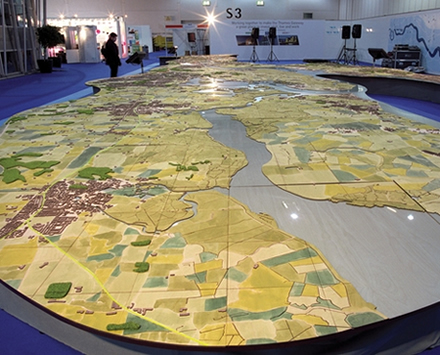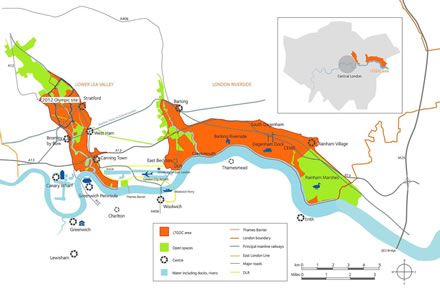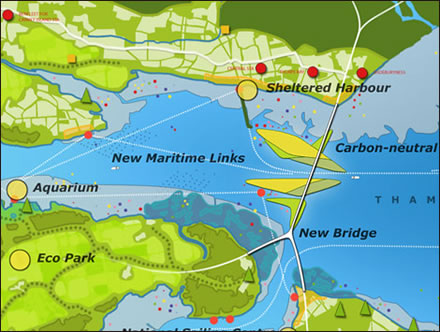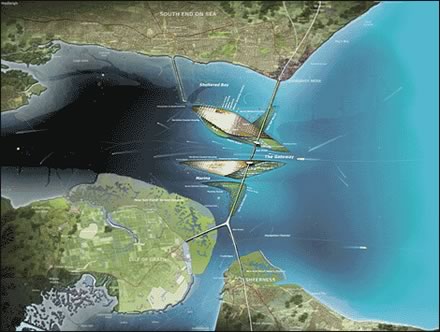
What will be built in the Thames Gateway? Will it be more like Broadacre City or Carpet City?
The Thames Gateway is an ideological battlefield. It is the stage upon which all architects, urban designers, theorists and doom-mongers can project their hopes, fears, visions and nightmares.
Not since the heady days of the Docklands development has their been a project of this scope in the capital. There is a tantalising prospect to make a new London, build a bright new future, and reject the mistakes of the past.
Thames Gateway has also become a massive investment opportunity for speculative house builders, property tycoons, and real estate magnates, clamouring for a piece of the baitball with all the decorum of a feeding frenzy.
With over 160,000 new homes proposed, over an area of 450 square kilometres, already home to 1.6 million people, the proposed density of the Thames Gateway development is actually very low. As the recent research by Chora puts it:
"The Thames Gateway is a complex urban field. It is 9 times the size of Barcelona, has the same population as Berlin and the equivalent density to Los Angeles."
But what kind of landscape will be created in the Gateway? In a recent Buidling Design 'debate' article (Is the Thames Gateway project a busted flush?), Grossmax's Eelco Hooftman eloquently busts the hyperbole of what is really happening in East London.
"The Thames Gateway is predominantly treated as an overspill housing scheme when it should really be about restructuring a landscape in a dynamic flood plain which considers flood defence, water storage, waste recycling, carbon footprint, ecological corridors, infrastructure and landscape frameworks.
It should be an architect-free zone until such a proposition is on the ground. We are heading for a diaspora of speculative toy town sink estates, a potent mixture of low-rise and high tide. We have dull, shifty opportunism when what we need is a long-term vision where imagination can take hold.
Large-scale landscape planning of any reasonable and positive kind is shamefully absent here. In fact, where is the plan at all? The proposition for a Green Grid across the Thames Valley is an anorexic, token gesture for a straightjacket landscape at odds with natural dynamics - what Thames Gateway needs is an altogether more voluptuous, ecological Wonderbra!"
If the secret "project" of Manhattan was the "culture of congestion", then the secret project at work here across the floodplains of the Thames Estuary is the culture of suburban sprawl.

Trying to understand what is actually proposed for the Thames Gateway is a difficult undertaking. It encompasses a large number of projects over a massive area, with well known elements such as the Olympic park in Stratford directing attention away from the real folly of the Thames Gateway - the massive suburbanisation of the Thames Estuary.
As the introduction catalogue for the 2006 exhibition Turning the Tide at New London Architecture, puts it:
"Tony Travers of the London School of Economics has described Thames Gateway as a ‘muddle of overlapping mechanisms’. Myriad organisations have an input into the development of Thames Gateway under the overall guidance of the Department for Communities and Local Government within central government. This list covers those connected with just the London end of the wider Gateway area and includes the interplay between local authorities, urban development corporations and local regeneration partnerships. "
Trying to read any coherent sense of a masterplan in the Thames Gateway is a tough exercise. There isn't even one coherent website for the Thames Gateway, just a lot of sites for the various development agencies each hawking the 'vision' for its own patch of turf. Surveyed as a whole, they run the gamut of the inept and the inane to the shockingly awful. If the online presentation of the Thames Gateway vision is such a dog's breakfast, what hope for any actual built form?


While he may have his detractors, Terry Farrell at least tried to bring some semblance of a grand vision to the Thames Gateway, and put landscape and nature at the centre of his masterplan vision (see also AR, Sep 2007). Farrell has been critical of an unfocused sprawl approach to the Thames Estuary, and instead favours concentrating the development closer to the centre of London, with 90% of the new housing proposed within the M25, leaving the outer limits as a new National Park.
While Farrell's plan ladles on the environmental buzzwords, promising 'eco-industrial parks' and 'sustainable floating islands', at its heart it provides a strong focussed vision that the current muddled approach sorely lacks.
Farrell's proposal, to more heavily urbanise central areas, building concentrated 'eco-cities' and leaving the outer gateway land largely undeveloped, is a heroic attempt to counter the prospect of suburban sprawl.
The current destiny of the Thames Gateway is as a new Los Angeles.
